List of Contents
What is the AI in Education Market Size?
The global AI in education market size is accounted at USD 7.05 billion in 2025 and predicted to increase from USD 9.58 billion in 2026 to approximately USD 112.30 billion by 2034, at a CAGR of 36.02% between 2025 and 2034. The increasing adoption of artificial intelligence technology and government spending on education globally is driving demand for the AI in education market.
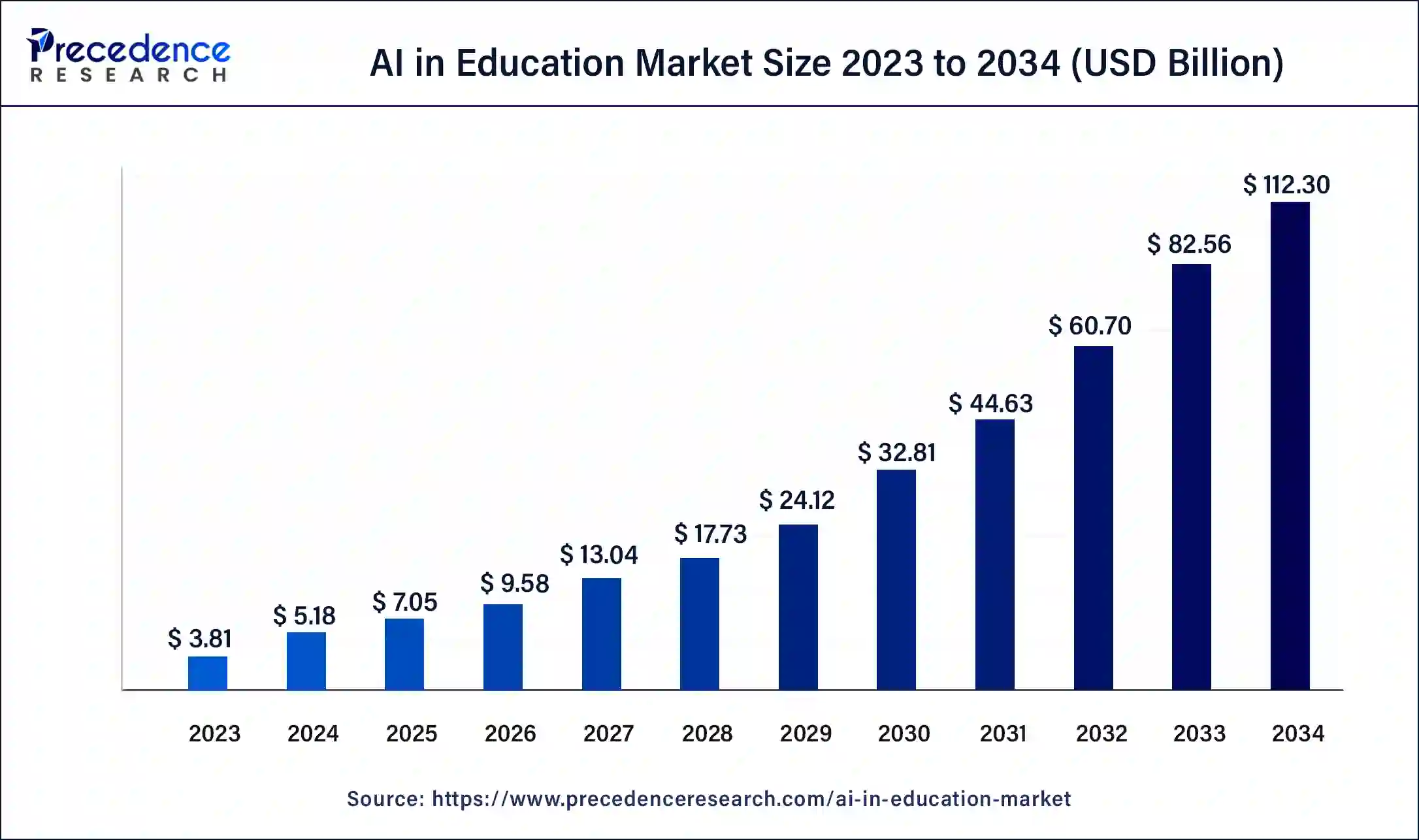
AI in Education Market Key Takeaways
- In terms of revenue, the AI in education market is valued at $7.05 billion in 2025.
- It is projected to reach $112.30 billion by 2034.
- The AI in education market is expected to grow at a CAGR of 36.02% from 2025 to 2034.
- North America dominated the AI in education market with the largest market share of 38% in 2024.
- Asia Pacific is expected to host the fastest-growing market during the forecast period.
- By component, the solutions segment has generated more than 72% of market share in 2025.
- By component, the services segment is expected to grow at a double digit CAGR of 37.15% during the forecast period.
- By deployment, the cloud segment contributed the biggest market share of 57% in 2025.
- By deployment, the on-premise segment is expected to grow at the fastest rate in the market during the forecast period.
- By technology, the machine learning segment accounted for the largest market share of 64% in 2024.
- By technology, the natural language processing (NLP) segment is set to grow at a remarkable CAGR 36.64% during the forecast period.
- By application, the learning platform & virtual facilitators segment has contributed more than 47% of market share in 2024.
- By application, the smart content segment is expected to expand at a solid CAGR of 37.84% during the forecast period.
- By end use, the higher education segment made up the largest share of the market in 2024.
What are Emerging Catalysts in the Adoption of AI in Education?
Artificial intelligence in education is the process of integrating AI technologies to improve the quality and effectiveness of education and create better learning outcomes. AI in education assists in personalizing learning experiences, improving teaching practices, and supporting educators through tools and insights to create quality education environments. High global smartphone penetration has also contributed to AI in education, helping address the global gaps in education by enabling educators to reach remote areas.
Developments in artificial intelligence increased public and private spending in education, and the growth of edutainment is driving growth in the AI in education market. The COVID-19 pandemic provided a huge boost to the market as educational institutions and schools globally had to switch to remote teaching models.
Also, slow digitizations in emerging economies, coupled with the lack of a robust IT infrastructure, have been challenges to growth in the AI in education market. AI-based education is heavily dependent on existing IT infrastructure, data, and the Internet of Things to function. While smartphone penetration is high, the lack of proper cloud infrastructure and support services restricts growth in the sector.
- According to the UNESCO Education Finance Watch report, government spending on education in low-income countries as a percentage of GDP rose from 3.2 percent in 2018 to 3.6 percent in 2021 during the pandemic.
AI in Education Market Growth Factors
- The integration of AI technologies into education have led to better learning outcomes through customized lessons, the introduction of chatbots and data driven decision making. These developments have boosted growth in the market.
- The increasing use of AI-powered tools by educators in high-incomes nations has led to demand in the AI in education market.
- Adoption of AI in education has led to lower educator administrative workloads and improved classroom interactions and engagement.
Key Factors Influencing Future Market Trends
- Personalized learning demand: Personalized learning experiences in the educational system are contributing to the adoption of AI in the educational system. This increasing demand prompts universities and schools to introduce intelligent tutoring systems and adaptive learning platforms to accelerate distinctive academic improvement and maximize performance.
- Digital adoption in education: With the evolution of digital infrastructure in the wake of the pandemic, it is now time for education to embrace AI to a greater extent. Universities and colleges are moving to e-learning platforms, utilizing smart content approaches and building virtual classrooms.
- Increasing EdTech investments: The funding from governments, private organizations, and education providers has grown in scope and size towards the development and adoption of AI solutions that improve assessment and content development and provide individualized learning trajectories.
AI in Education Market Outlook
- Global Expansion: Specifically, the growth is fueled by the escalating requirement for tailored learning, administrative effectiveness, and expanded student outcomes.
- Major Investor: In July 2025, Microsoft planned to invest over USD 4 billion in AI education, with a focus on training millions of individuals through schools, community colleges, nonprofits, and its newly started Microsoft Elevate Academy.
- Startup Ecosystem: Frizzle, a startup that employs AI to grade handwritten math assignments in minutes, facilitating teachers with rich analytics and differentiated assessments to customize instruction.
Market Scope
| Report Coverage | Details |
| Market Size by 2034 | USD 112.30 Billion |
| Market Size in 2025 | USD 7.05 Billion |
| Market Size in 2026 | USD 9.58 Billion |
| Market Growth Rate from 2025 to 2034 | CAGR of 36.02% |
| Largest Market | North America |
| Base Year | 2024 |
| Forecast Period | 2025 to 2034 |
| Segments Covered | Component, Deployment, Technology, Application, End-use, and Regions |
| Regions Covered | North America, Europe, Asia-Pacific, Latin America, and the Middle East & Africa |
Market Dynamics
Drivers
AI-based educational technology is leading to better learning outcomes
AI-based are used to analyze student data and tailor educational instructions to an individual learner's pace based on their strengths, weaknesses, and interests. AI systems and big data analytics allow educators to receive real-time information on student progress and areas of improvement.
- In October 2024, a Forbes Advisor survey conducted in the United States found that 55% of educators found that AI improved educational outcomes. Of the 500 educators surveyed in the country, 60% used AI tools in their classrooms.
AI-powered tools providing support for educators
In the AI in education market, natural language processing technologies are powering chatbots to provide students with 24/7 access to doubt support and course material. Chatbots also assist educators by mitigating availability issues. In tertiary education, educators use AI to automate grading tests, test for plagiarism, and reduce administrative workload, leaving more time to engage with students.
- In March 2024, Indian software company Pinak Ai launched an AI-powered conversational chatbot for students preparing for the country's Civil Services Examination. The chatbot was launched as an app on Android and iOS and is intended to fetch real-time information on various topics and current affairs.
Restraint
Lack of adequate IT infrastructure and slow digitization
Information iechnology infrastructure, crucial for AI in education, is still lacking in many emerging economies. Despite smartphone penetration remaining high and the cost of internet data plans falling, low quality of internet connectivity and a lack of compatible devices, especially in underdeveloped regions, restrict the growth of AI in education. The lack of skilled professionals in the region further challenges growth in the AI in education market.
Further investment is necessary in the digital infrastructure landscape in regions like Africa and Asia Pacific. According to the Pew Research Center, while computer usage has increased significantly in many countries, particularly in Europe, it is growing relatively slowly, if at all, in parts of Asia, Africa, and Latin America.
Opportunity
Data-driven decision-making with AI
As the AI in education market continues to grow, opportunities for large-scale data collection over the years will enable AI-based decision-making. Utilizing generative AI to analyze the student data captured by government and private educational institutions will help them make informed decisions about their curriculum. AI-powered tools will also be able to streamline recruitment, resource allocation, and day-to-day administration.
Component Insights
The solutions segment dominated the global AI in education market in 2024. Rising disposable incomes and established IT companies, especially in large emerging economies such as India and China, have led to substantial growth in smartphone penetration in the Asia-Pacific. The large-scale expansion of digital payment options such as the Unified Payments Interface or UPI in India has also led to the growth of subscription-based educational websites and edutainment apps.
- According to the National Payments Corporation of India, the UPI transaction volume stood at 12,924.97 million transactions in June 2024 alone.
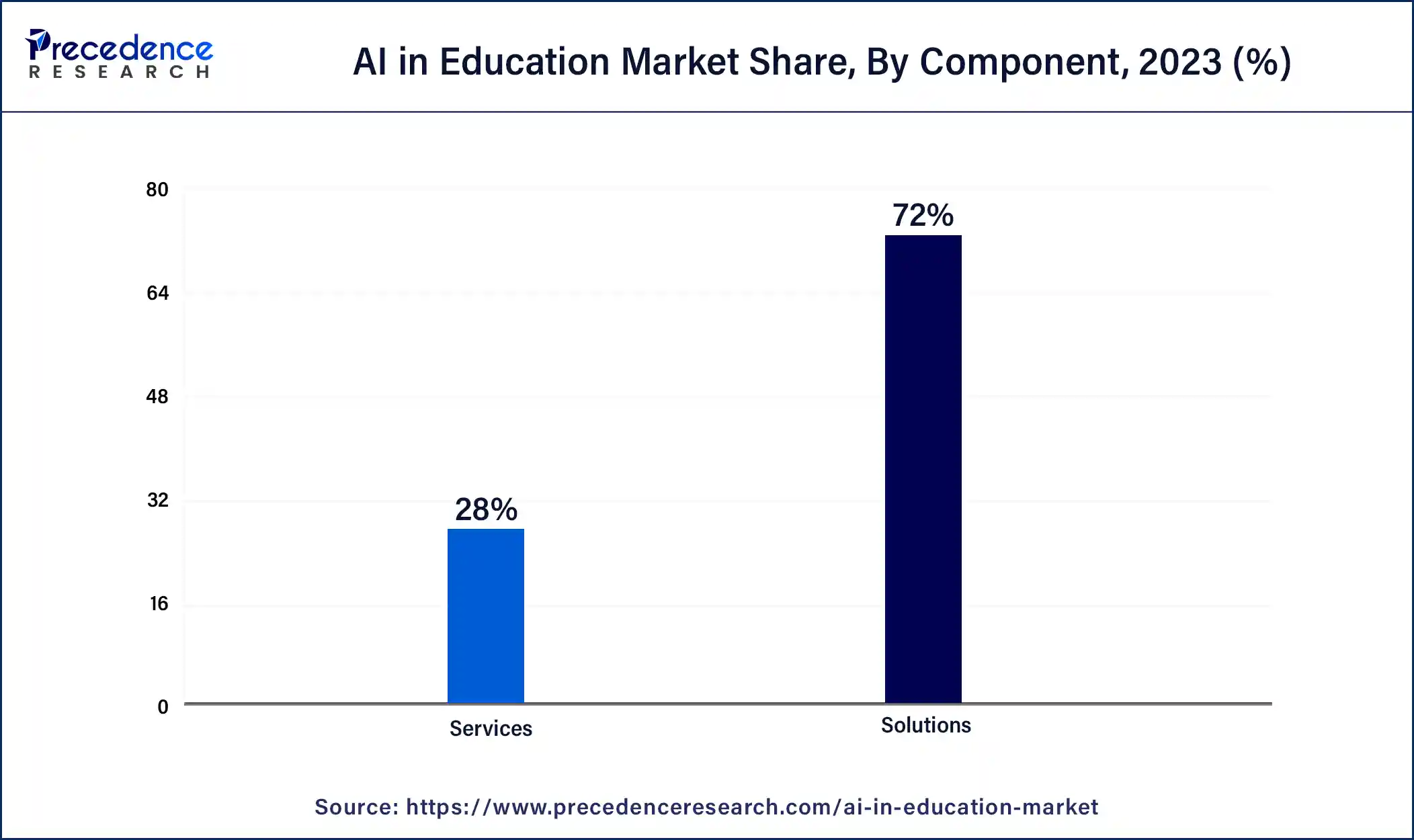
The services segment is expected to grow at the fastest rate in the AI in education market during the forecast period between 2025 and 2034. Since the COVID-19 pandemic, an interest in online education has risen steadily, with increasing investment by government and private organizations in the education sector. Several education startups providing services, such as education personalization and task automation, have sprung up in emerging economies. Companies are also increasingly providing intelligent content systems that assist in visualization and simulation solutions for better information perception, which have also entered the market.
Deployment Insights
The cloud segment dominated the AI in education market in 2024. Rising costs in the sector are pushing educational institutions to outsource data management and storage. Cloud computing uses hosted services such as data storage, networking, servers, and software maintained by a cloud service provider.
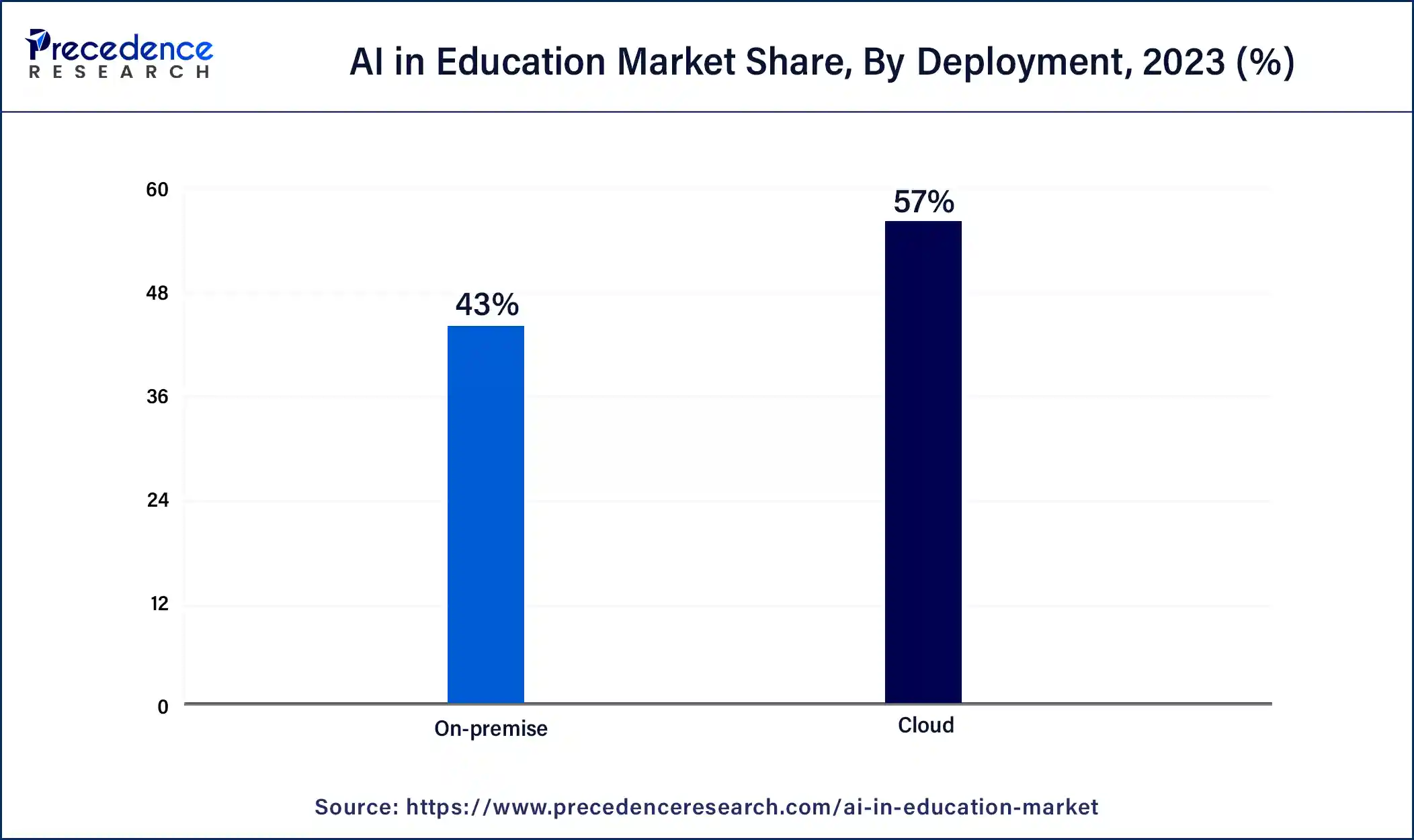
The on-premise segment is expected to grow at the fastest rate in the AI in education market during the forecast period between 2024 and 2033. Educators are increasingly switching to on-site data storage solutions to address data privacy concerns and security risks such as cyber-attacks and data breaches.
- According to data analyzed by India Today's Open-Source Intelligence team, at least 65 major examinations across 19 Indian states have been subject to question paper leaks since 2019.
Technology Insights
The machine learning segment made up the largest share of the AI in education market in 2024. Machine learning solutions are contributing to conversational AI chatbots. These systems allow students around-the-clock access to assistance with doubts, virtual mini-lessons, and assistance with homework.
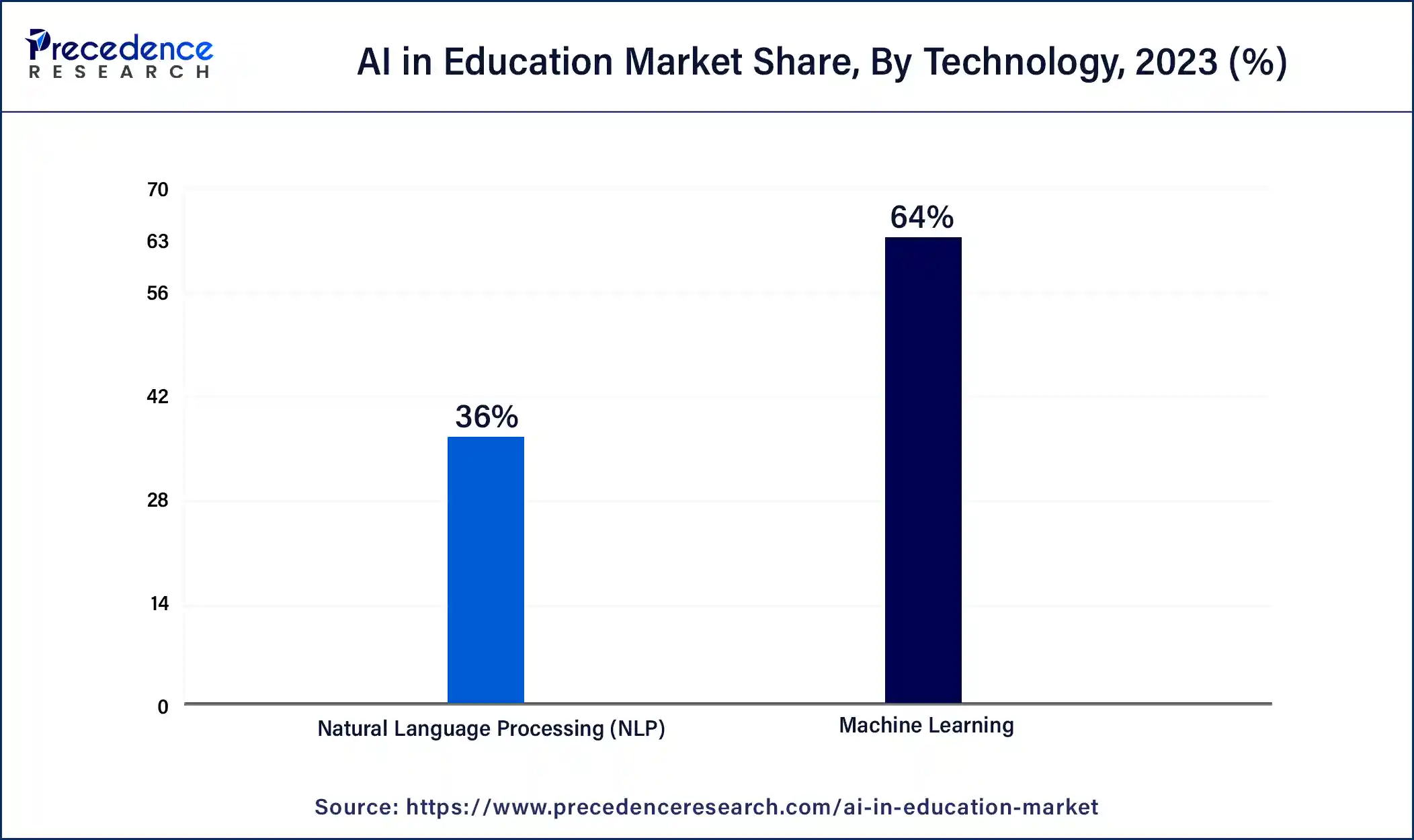
The natural language processing (NLP) segment is set to grow at the fastest rate in the AI in education market in the forecast period. The segment is integrated with several educational contexts, such as science, linguistics, online education, and research. Natural language processing solutions provide solutions to assist in writing, analysis, and assessment procedures, such as grammar checkers. Grammar checkers are websites or apps that check for the grammatical correctness of a text through natural language processing and grammatical rules to identify mistakes and syntax errors.
Application Insights
The learning platform & virtual facilitators segment led the global AI in education market in 2024. The growth of digital education technology adoption across the world, with investments from governments, is providing a boost to this sector. In India, individual state governments are teaming up with e-learning platforms to provide AI-based solutions for their educational institutions.
The Indian government has announced a New Education Policy in 2020 focusing on maximizing online education opportunities. The Indian Department of Education allocated IND? 73,498 crore, the highest ever, in the budget for 2024-25.
The smart content segment is expected to expand at the fastest rate in the AI in education market in the forecast period between 2024 and 2033. Smart content refers to digital educational materials such as animations, interactive videos, 3D models, and multimedia presentations. These work to create a more immersive learning experience for students. Natural language processing and computer vision are used to increase the interactivity of lessons.
End-use Insights
The higher education segment made up the largest share of the AI in education market in 2024. The rising academic standards, large-scale standardized testing, and shift away from rote learning in emerging economies have driven demand for this sector. Educators are encouraged to focus more on the development of critical thinking and problem-solving abilities in preparation for higher studies and careers. Corporate training programs are also picking up steam with increasing demand for employee skill enhancement to stay competitive in the rapidly changing technological landscape.
Regional Insights
U.S. AI in Education Market Size and Growth 2025 to 2034
The U.S. AI in education market size is exhibited at USD 2.01 billion in 2025 and is projected to be worth around USD 32.64 billion by 2034, poised to grow at a CAGR of 36.21% from 2025 to 2034.
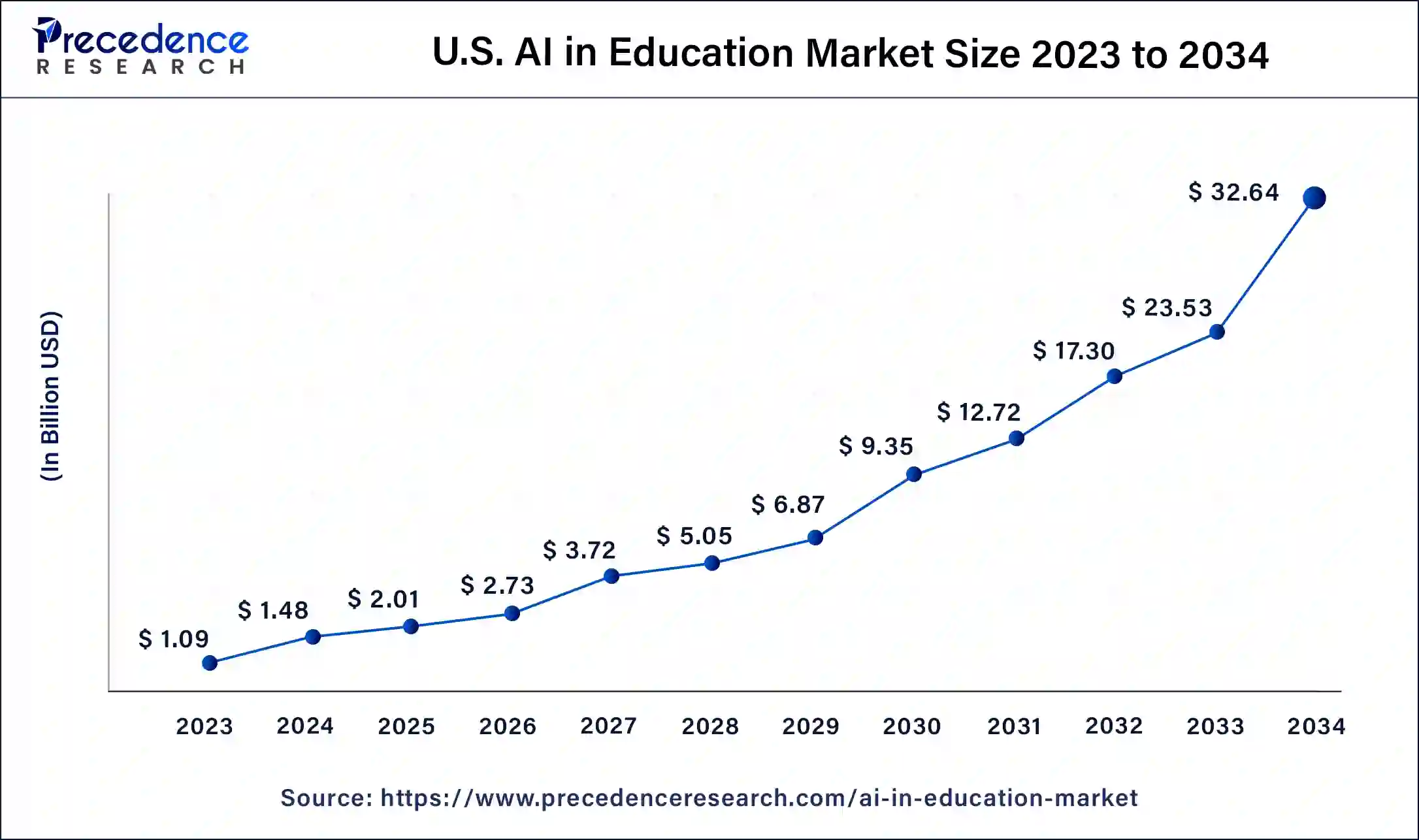
What Made North America Dominant in the Market in 2024?
North America dominated the AI in education market in 2024. Substantial investment from Silicon Valley giants such as Google, Microsoft, Apple, and IBM in education has contributed to the market's success in the region. The robust information technology infrastructure in the region has led to the widespread adoption of AI technology in education. The United States government's investment in education has also spurred growth in the market.
- In 2022, the U.S. Department of Education Office of Educational Technology announced a national education technology policy to use technology to revolutionize teaching and learning. Congress also allocated $2.75 billion for the Digital Equity Act to work towards including all individuals and communities in the digital economy by setting up high-speed internet across the country.
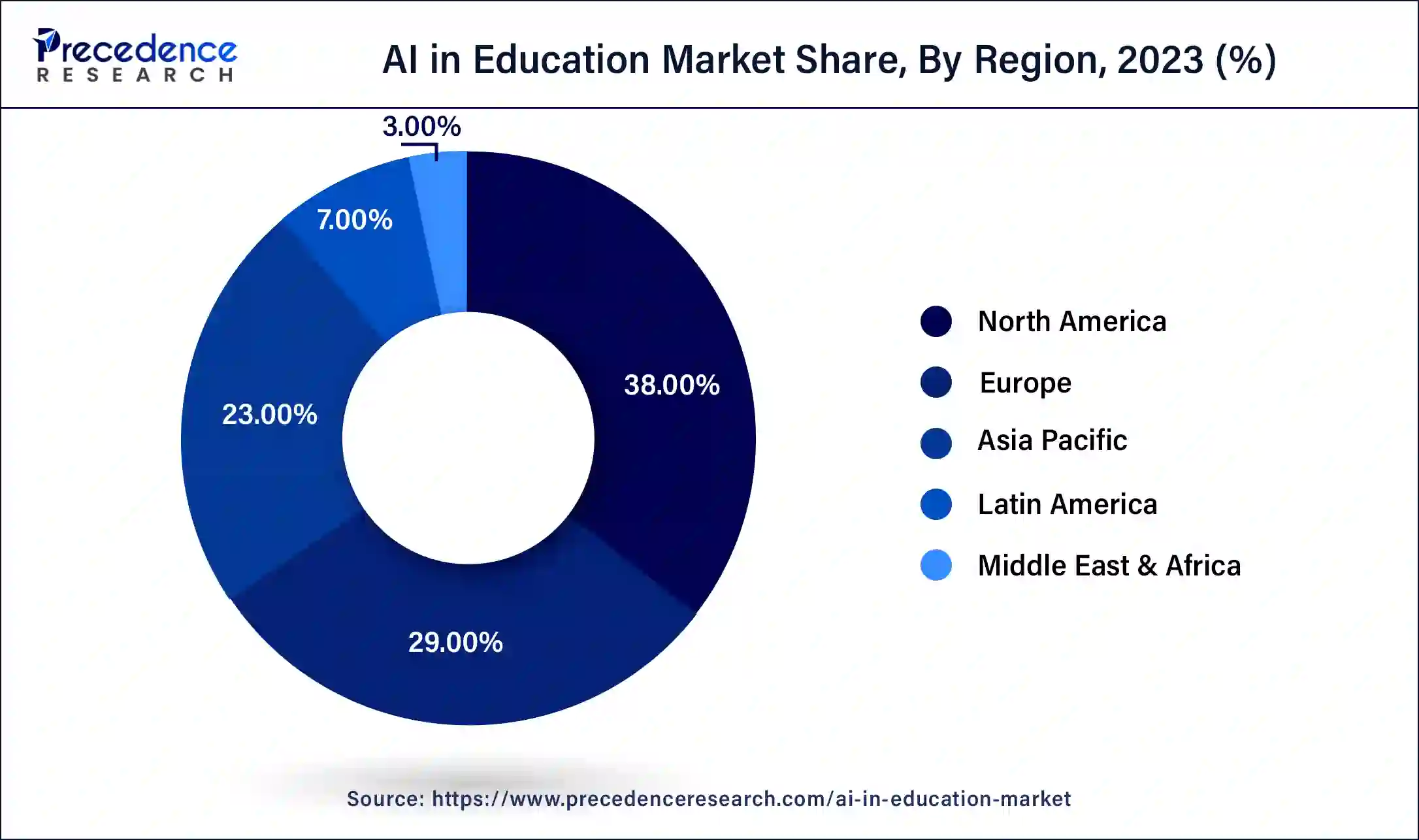
Surging Startups in Novelty are Encouraging the Asia Pacific
Asia Pacific is expected to host the fastest-growing AI in education market during the forecast period. The advent of large AI-based learning startups in the region, such as the South Korean Rid and Knowre, the Chinese Squirrel AI, and Unacademy in India, is spurring growth in the region.
- According to Indian educational startup Unacademy, their offline centers grew from tutoring 6,000 learners in 2022 to 32,000 learners in 2024. The company also managed to reduce its cash burn by 60% during the last eight years.
Impactful Federal Step: U.S. Market Trend
The U.S. is considered a highly digitalised region in numerous sectors, including education, where a White House Executive Order, "Advancing Artificial Intelligence Education for American Youth," was signed to unite AI education across all levels of learning, from K-12 to postsecondary, in April 2025. The U.S. Department of Education also revealed guidance supporting schools to employ existing federal grants for AI integration, like as high-impact tutoring and automating tasks.
Ongoing Commitments in Training & Infrastructure: South Korean Market Trend
Recently, the South Korean government delivered approximately $740 million for 2024-2026 to train teachers on AI tools and methodologies, with a focus on the shift from instructors to facilitators and mentors. As well as they have invested nearly $70 million in expanding digital infrastructure, facilitating digital tutors, and developing technical support for teachers.
Implementing a Particular Framework is Assisting Europe
In May 2025, the European Schools system has established a specific framework for the educational use of generative AI, with a focus on raising AI opportunities and ensuring its use aligns with legal, ethical, and human-centred principles. However, UNESCO offered guidance for policymakers, such as AI competency frameworks for students and teachers, to support countries in integrating AI into their educational systems responsibly.
Progressing AI Tools: UK Market Trend
In recent days, the UK's government invested £4 million focused on designing AI tools for tasks, including lesson planning and marking homework. This is further assisting many universities, such as the University of Manchester is increasingly using Microsoft Copilot to automate administrative and curriculum development tasks.
Key Players Offerings:
- Aleks- It offers an AI application in creating a tailored learning path by first assessing a student's knowledge state and determining their specific strengths and weaknesses.
- Riid- A major company provides one-on-one, AI-enabled tutoring experiences to individual learners effectively.
- DreamBox Learning- A platform that explores AI-assisted analytics and reporting to help educators monitor expansion and intervene efficiently.
- Kidaptive- It mainly assists in analyzing learning patterns, response times, error frequency, and engagement levels.
Osmo- This offers an extensive, hands-on learning experience and immediate feedback to children.
AI in Education Market Companies
- Aleks
- Riid
- DreamBox Learning
- Kidaptive
- Osmo
- Memrise
- Amazon Web Services, Inc.
- IBM Corporation
- Microsoft Corporation
- Cognizant
- Google LLC
- Pearson Plc
- BridgeU
Recent Developments in the AI in Education Market
- In November 2025, SWAYAM, the Government of India's free online learning platform, unveiled seven new AI courses developed for learners across various disciplines from science and commerce to education and sports.
( Source-https://digitallearning.eletsonline.com ) - In October 2025, the Government of Jordan and Replit collaborated with the launch of the pilot phase of "Siraj", an AI-enabled learning assistant created to revolutionize education across the Kingdom.
( Source-https://www.prnewswire.com )
Segments Covered in the Report
By Component
- Solutions
- Services
By Deployment
- Cloud
- On-premise
By Technology
- Natural Language Processing (NLP)
- Machine Learning
By Application
- Learning Platform & Virtual Facilitators
- Intelligent Tutoring System (ITS)
- Smart Content
- Fraud And Risk Management
- Others
By End-use
- K-12 Education
- Higher Education
- Corporate Training & Learning
By Region
- North America
- Asia Pacific
- Europe
- Latin America
- Middle East & Africa
For inquiries regarding discounts, bulk purchases, or customization requests, please contact us at sales@precedenceresearch.com
Frequently Asked Questions
Ask For Sample
No cookie-cutter, only authentic analysis – take the 1st step to become a Precedence Research client